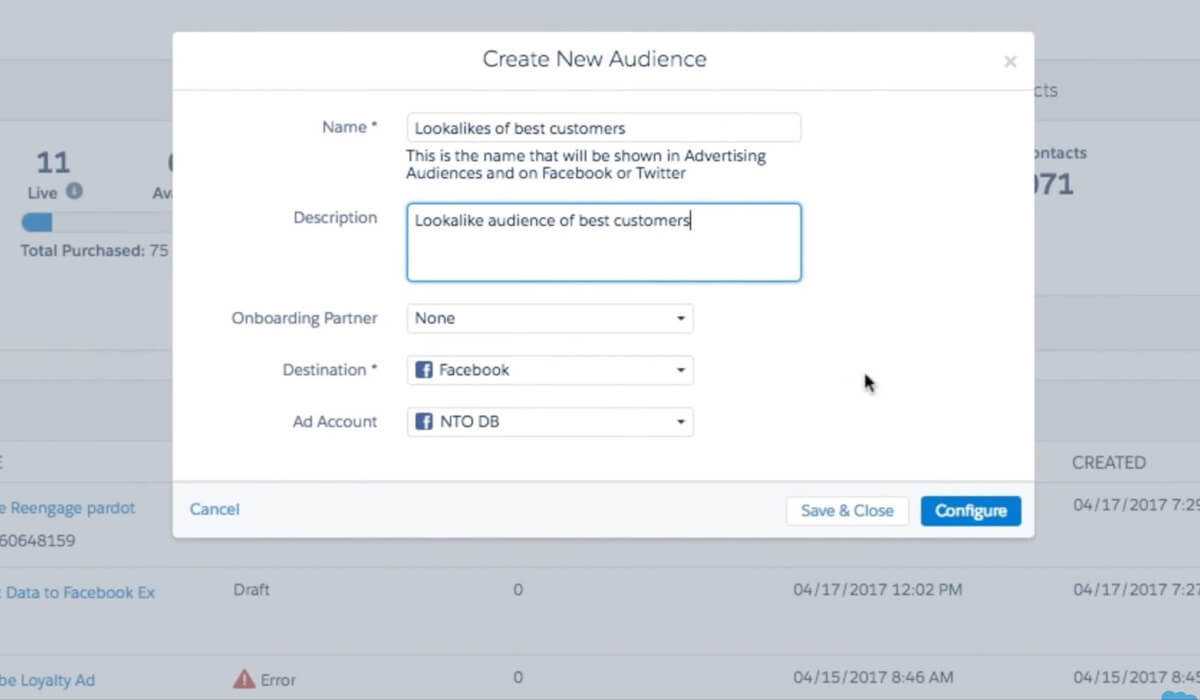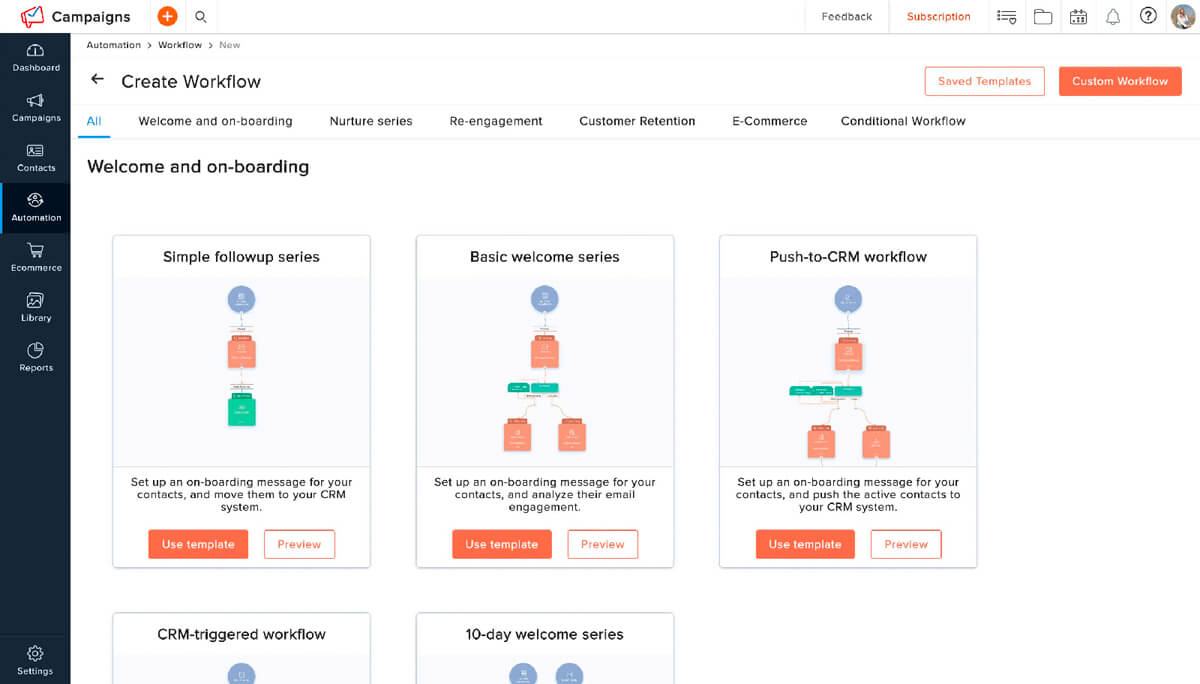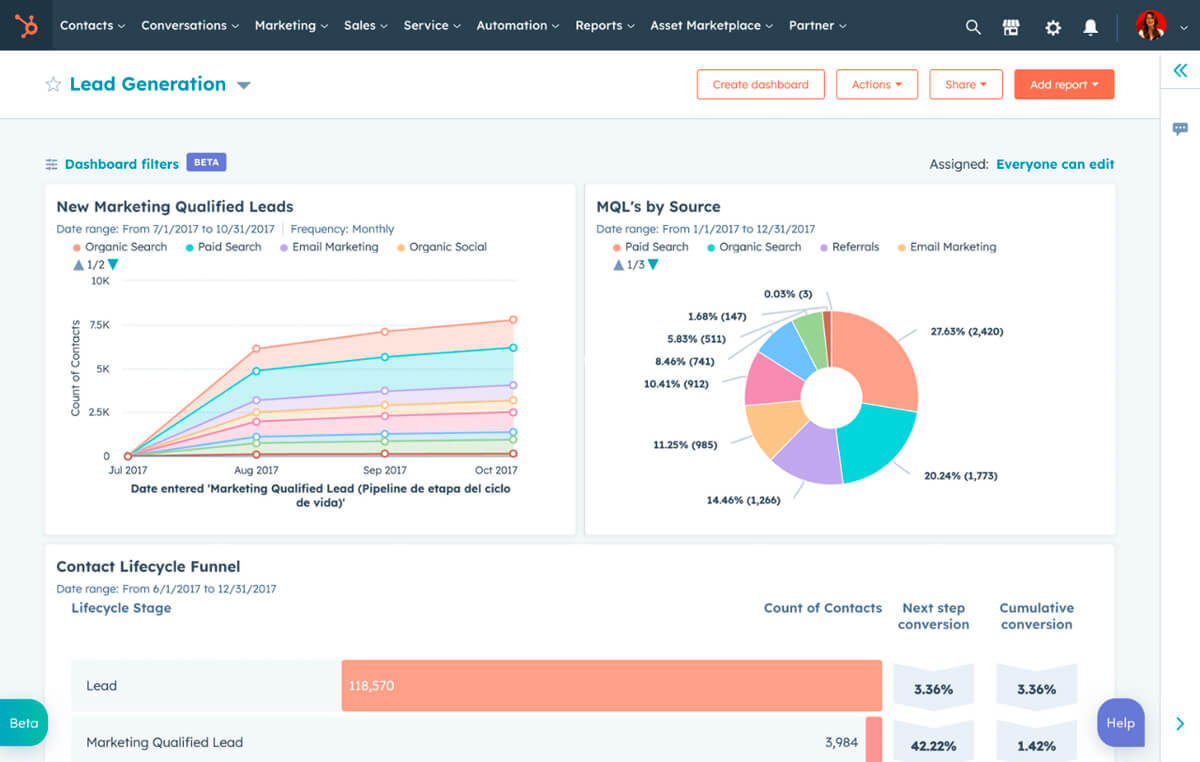Looking for the best CRM for freelancers? Check out our list of the top six CRM solutions for freelancers in 2024 to get the best features for your business.
CRM advertising is a method of linking the data gathered by your CRM with your paid social media platforms and other advertising networks in order to create personalized messaging across different customer touchpoints. Leveraging CRM datasets in your advertising can help you ensure the prospective customer’s initial engagement leads along the path to conversion, giving you the info you need to craft a holistic and tailored experience across all interactions.
Salespeople and marketers that use CRM advertising start by collecting data on their customer interactions and demographics using CRM software that offers features such as email and social media integrations, web analytics, automations, and revenue tracking. They then segment customers into specific groups and serve these segments with personalized advertising content through various marketing channels.
Once an ad is live, it’s displayed to the target audience and its performance can be monitored via your CRM. When someone clicks on the ad, the information collected, such as website interaction and conversion data, is also tracked in the CRM.
The basic process of CRM advertising is as follows:
By following these phases, you can set up effective advertising campaigns and harvest further data for customer retention and analytics, enabling you to more easily adapt to the behaviors of your target audience. Throughout this process, also identify patterns, preferences, and pain points to refine your strategy further. For example, if data in your CRM reveals that a specific type of content or messaging resonates more with your target audience, prioritize and expand upon that approach.
There are a range of benefits that come with well-executed CRM advertising. These not only stem from the diverse pool of data available for later advertising decisions, but also from developing an efficient and centralized way of managing your advertising campaigns.
The benefits to investing in CRM advertising can have huge rewards on the impact of your upcoming advertising campaigns and how you define your future advertising strategy in the long run. Among the advantages are the opportunity to personalize the ad experience for your customers, achieve higher engagement from them, attract more qualified leads, use your budget more efficiently, and help streamline your internal operation.
There are practical methods of leveraging your CRM for advertising and experiencing these benefits, ensuring that your campaigns feature high-quality content and reach the right audience for maximum impact.
Some of the most effective ways to use your CRM for advertising include taking advantage of lookalike customer personas, marketing automation, and analytics. The quality of content used in social media advertising, mobile advertising, and paid search is a big part of advertising success, but showing the right content to the right people is essential to making sure your campaigns reach their maximum conversion potential.
A great way to take advantage of your CRM’s features and capabilities is to create lookalike audiences from previous data gathered through your social media advertising platform’s pixel or another tag embedded on your site. These pixels can be useful for leveraging your CRM data to improve the accuracy of your targeting, as the data you gather is from direct customer interactions rather than third-party cookies.
Aside from this, using your CRM data in advertising will allow you to create audiences based on segments that social advertising analytics aren’t able to pick up. This might include site behavior data older than 180 days (the typical maximum lifespan of pixel audiences), customers who found you through offline channels, and customer parameters you might set using your CRM data like customer lifetime value, average order value, and cost of retention.
Utilizing lookalike audiences with your best possible data can help align advertising campaigns more closely with your ideal customers and work wonders for your advertising cost per acquisition.

The wealth of data available through your CRM can help you set up useful automation rules to improve campaign efficiencies and align sales and marketing within your organization. Review the audience segments you’ve created and align rules and automation workflows with the people within your audience for whom the rule is most relevant.
For example, if you've identified an audience segment within your CRM data that shows a high engagement with content related to a specific function of your product, such as a video editing feature, you can set automation rules that target this segment with this specific kind of content in the future. Leveraging this insight may involve creating a trigger within your CRM that activates when a lead visits a how-to guide for video editing on your website, for example.
This trigger, driven by your CRM automation, can initiate an automated advertising campaign with highly specific content; the ad creatives for this campaign will be exclusively tailored to the topic of video editing, showcasing the benefits and features of this function. By delivering content that aligns precisely with your audience's actions, the chances of capturing their engagement with each impression significantly improve.
You can eventually refine your campaigns with further conditions — such as for leads showing engagement within a specific time frame or achieving a certain lead score — to enhance your automation and improve cost efficiency for your budget.

For better results and deeper insights, use CRM data to complement the insights gleaned from your advertising platforms to inform your future campaigns and achieve a healthier ROI. The most useful CRM datasets worth integrating into your advertising platform include those related to conversion attribution, cost per acquisition (CPA), customer acquisition cost (CAC), lifetime value (LTV), and churn rate analysis.
Let’s look at each one in detail:

These cover just a few of the use cases where CRM features can work hand in hand with advertising. When combined with the right CRM, you’ll soon be able to optimize your advertising campaigns and improve outcomes across your paid marketing projects.
The various features of a CRM can be applied to markedly different advertising tasks, including ad creation, performance analysis, predictive analysis, and more. Some of the top CRM software that can help you with advertising include Zoho CRM, HubSpot CRM, and Salesforce Marketing Cloud. Each software solution includes different features, strengths, and weaknesses that may make them better or worse for your unique advertising practices.
Now that we’ve seen how CRMs and ad platforms can work together, here’s a look at some of the best CRM software for advertising.
Zoho CRM is marketing software that provides a wealth of audience tracking and segmentation tools to build a clearer picture of lead behavior to inform advertising campaigns. Zoho can gather data from site forms, generate personalized promotions for individual customers, and automate email list management with user behavior rules. It also features a built-in Google Ads integration, allowing you to see ad campaigns as part of the sales process in your CRM.
Zoho CRM offers a free version that comes with standard reporting but is limited to three users. If you’re looking for more flexibility in terms of automation, custom reporting, and integrations with other tools, it’s worth considering the paid plans, which start at $14 per user, per month for a Standard plan.
HubSpot CRM is a sales and marketing CRM that makes it easy to merge disparate marketing campaigns into a user-friendly view and instantly see your sales pipeline data in the context of ad campaigns. The upgraded Marketing Hub features also allow you to build and manage ad campaigns using CRM data, create highly personalized ads, and report on ad performance across Google, Facebook, Instagram, and LinkedIn from a single platform.
HubSpot CRM offers a free version that gives you access to all of its foundational tools. Marketing Hub plans start at $800 per month and integrate with HubSpot's free sales, service, CMS, and operations products.
Salesforce Marketing Cloud is a popular CRM with robust ad analytics capabilities. Its tools for capturing web users’ data, managing leads, and creating web forms allow you to monitor all kinds of interactions with your brand and build a detailed picture of what your audience wants. The CRM comes with a customizable dashboard that provides a full picture of how you’ve interacted with leads and prospects in the past, including a log of any complaints.
Salesforce is the most expensive of these three options, costing at least $1,250 per organization, per month for the Pro tier.
Any one of these CRMs will equip you with the tools to start building advertising campaigns. However, it’s important to still keep in mind your specific requirements and goals for your unique campaign. More specifically, you should inform your strategy with detailed insights into your audience and ensure you fully understand which software will help you overcome some of the biggest challenges associated with combining your CRM and advertising.
Understanding the challenges of CRM advertising will further inform your choice when selecting the most suitable software for your advertising channels. However, there are many pitfalls you may encounter as you try to make CRM advertising a working part of your marketing strategy. Here are some of the key challenges of CRM advertising you may face, as well as some advice on how to overcome them.
Familiarizing yourself with the potential challenges ahead as you start to engage with CRM advertising is crucial to making sure the integration serves your goals well and your strategy accounts for potential pitfalls and ways to work around them.
With the right approach, CRM advertising can give you a detailed view of who your audience is, how they’re interacting with your brand, and how to use these insights to craft more profitable ad campaigns. Adopting a data-driven approach to advertising that uses CRM software provides marketing teams with a more holistic marketing strategy — not to mention a unified advertising management platform — that will increase ROI for your advertising campaigns.
If you’d like to know more about how to optimize your online advertising, check out our article on quality PPC lead generation.